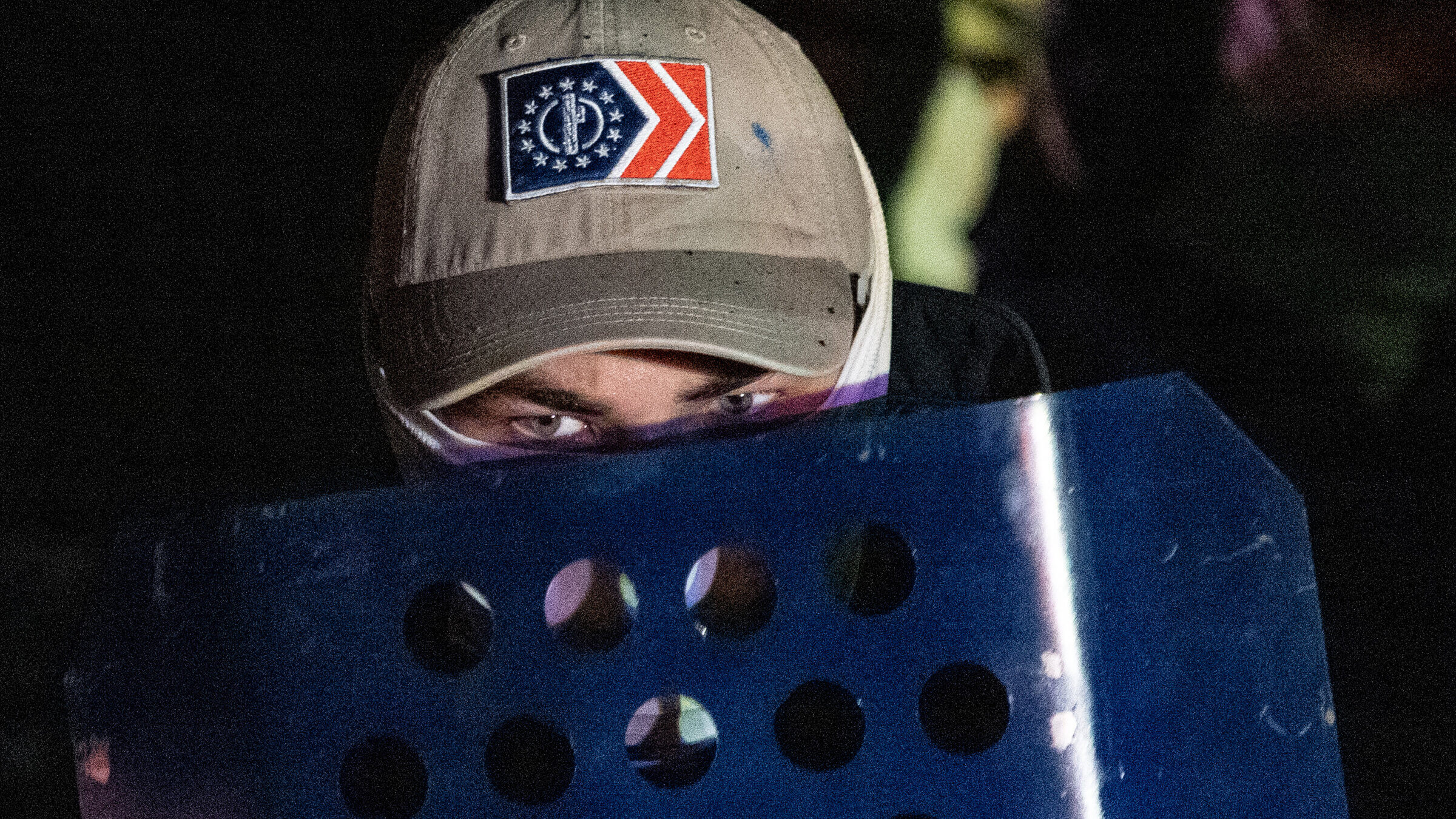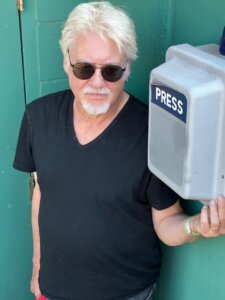Can Massachusetts really be as antisemitic as they say?
The state may have the country’s fourth-highest percentage of Jews, but a recent report from the ADL is cause for alarm

A member of the rightwing group Patriot Front. Photo by Getty Images
I’ve long held to the belief that Massachusetts, the state I’ve chosen to live in — have lived in for 45 years — is, if not the most progressive state in the country, right up there.
It’s true that we elect moderate Republicans (remember them?) like Charlie Baker or Bill Weld to the governorship once in a while. But we voted for George McGovern in 1972 — the only state to do so — and we gave America Tip O’Neill, Elizabeth Warren, John Kerry, Barney Frank and Ted Kennedy.
I’ve always seen myself as left-of-center, not radically so, but decidedly. It goes back to my childhood and upbringing in the 1960s, the Civil Rights Movement and the Vietnam War. In my world, progressivism speaks to a certain belief in social justice and an inherent respect for diverse cultures.
But then last week, the Anti-Defamation League’s Center on Extremism reported that Massachusetts has just been ranked second in the country when it comes to white supremacy – trailing only Texas — and we’re No. 6 when it comes to antisemitism, a 41% jump from 2021 to 2022.
I’m no Pollyanna, but in my — apparently sheltered, it turns out — view of the world, Massachusetts has seemed a bastion of progressivism, safety and sanity: sensible (restrictive) gun laws, no school shootings, a surfeit of open-minded universities like Brandeis and strong laws protecting abortion rights. An atmosphere of tolerance.
We know rural areas of certain states such as Michigan, Ohio and Pennsylvania have become staging grounds for armed militia groups. But in 2018, the Southern Poverty Law Center reported none of their ilk taking up residence in Massachusetts.
I live in Brookline, which was described in 2015 as “Greater Boston’s Jewish Hub.” Massachusetts may not be as Jewish as it once was, but according to 2020 statistics, it has the fourth-highest percentage of Jews in the country after New York, Washington, D.C., and New Jersey, at 4.3 % or 293,080 people.
According to the ADL’s rhyming press release, “Hate in the Bay State,” the increase in antisemitism “is due, in part, to white supremacist groups operating in New England, including the neo-Nazi Nationalist Social Club (NSC-131) and their recently announced hateful “People’s Initiative of New England.”
“Notably,” the release goes on to say, “Massachusetts has experienced the nation’s second-highest rate of white supremacist propaganda, including hateful fliers, leaflets and banners, and extremists held 34 in-person events across the state in 2021 and 2022. Meanwhile, Massachusetts faces the country’s sixth-highest rate of antisemitic harassment, vandalism and assault.”
So, what do those statistics mean?
I asked Peggy Shukur, the ADL New England’s interim regional director, who these white supremacists are and about the nature of the antisemitic incidents: Was it idiot kids painting swastikas on walls, fences and gravestones or more physical intimidation and real-world violence?
“Great question,” she said. “But I don’t always focus on the perpetrator. I sometimes focus on the impact on community. A kid who paints a swastika at a train station in Natick, maybe that was someone who didn’t know better. What I like to focus on is the impact of a symbol like that. It has an effect on a number of people. With a young person in school, there’s an opportunity to turn it into a teachable moment. Not so when it’s presented by an extremist group saying “Jews did 9/11’ or the National Social Club hanging a banner over a freeway. These people, they’ve come with intention to spread fear and intimidation. Different situations require different solutions.”
Shukur places the blame for much of this on two groups, NSC-131 and Patriot Front, national organizations that “make explicit statements, focusing on New England, in part because they plan activities to maximize media attention and play to their base. Marching around Boston Common gets more attention than marching around Anytown, USA. Massachusetts has iconic sites that make a perfect palette for these groups. We shouldn’t assume these views are just held in rural areas or by ‘uneducated’ people. I think we have to acknowledge there’s a lot of disinformation and misinformation that’s become part of educated people’s lexicon, too.”
I asked if there was any possibility these numbers could be higher than expected, because, perhaps, the state is more diligent than most about reporting incidents?
“Theoretically possible, but hard to prove,” said Shukur. “The nature and number of incidents in Massachusetts is high and has been for years and that is not necessarily indicative of more people reporting.”
Shukur said she’d experienced “in public” a number of incidents and the people impacted. “How many were impacted, that part didn’t surprise me. Being ranked No. 2 to Texas [in terms of white supremacy], that was real eye-opening. In a Venn diagram, there’s a portion of extremist incidents that targets the Jewish community but also Black, LBGTQ+ and immigrant communities.”
She stressed, too, that with the internet’s vast reach “this type of hate has no boundaries. The extremists are getting their information from the deepest places on the internet, information and disinformation. They read it and feel emboldened to act on their hate. And that doesn’t follow state borders.”
Standing up to hate
In March, New England Patriots owner Robert Kraft, perhaps Massachusetts’ most prominent and wealthiest Jewish business owner, launched a $25 million national ad campaign, Stand Up to Jewish Hate, which included four different TV spots.
The mission?
“It’s a reminder to raise awareness at the national level and engage all of America that antisemitism exists,” said Matthew E. Berger who is the executive director of the Foundation to Combat Antisemitism.
The campaign started before the ADL released those stats, and Massachusetts, he said, was just a part of the antisemitic wave. “Unfortunately, we’ve seen a rise across the country and there does not seem to be a part of the county where it’s not growing,” he said. “While the Massachusetts numbers are disappointing, they’re not particularly surprising.”
I asked Berger how this antisemitism was most often manifested. Even if it was not prevalent in the public arena, he said, “We have to recognize when we allow the underlying antisemitism to go unchallenged, it creates an environment where it becomes acceptable and it escalates. If we start to address the graffiti, the antisemitic tropes about money and power, we prevent people from feeling they are free to be antisemitic. They may be innocuous but they create en masse stereotypes and misnomers and in the hands of the wrong person or moment can have real effect.
“No individual comment radicalizes somebody to bomb a synagogue, but it’s a lot of little things that add to the perceptions and stereotypes. A lot of it’s looking to blame somebody, people looking for scapegoats.”
The view from Brookline
So, back to my neighborhood. Does this report change how I feel about my town and my state?
Well, to an extent, yes. As it may be clear by my surname, I’m not Jewish, but my wife, Roza, is and my perspective on everything from comedy to music to politics has been, in no small part, shaped by Jewish culture from an early age. My wife and I walk the nearby streets in relative calm. We live in a very low-crime suburb.
Are we — particularly Roza — more wary these days?
Sure.
And there was this JuJu thing. A couple of years ago, Roza had placed a clay planter outside our home in the shrubbery. We came home one day to find the phrase JuJu scrawled in black on it.
What did it mean?
We went to the Brookline police. The guy at the desk, who was Jewish, thought it was normal teenage vandalism, but not antisemitism. He didn’t equate “JuJu” with “Jew.” Or maybe he just didn’t want to file a report on antisemitism, create an “incident.” Roza felt differently, targeted, and thought it most definitely antisemitic. Me, I didn’t know.
So, we can’t be certain of the intent. It does linger in the back of the mind, though, like a lot of potential antisemitism triggers do. And with the news of these new statistics, it creeps just a little further to the front.
















